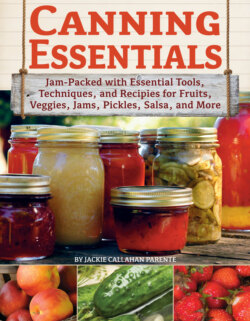Читать книгу Canning Essentials - Jackie Callahan Parente - Страница 20
WATER-BATH CANNING
ОглавлениеAfter preserving food in glass jars using two-piece metal lids, you submerge the jarred food in a boiling-water bath for a specified period of time to destroy any harmful microorganisms and inactivate enzymes. Subsequent cooling creates a vacuum seal, which prevents air and other microorganisms from entering and causing spoilage. This method works well for a range of fruits, tomatoes, and other high-acid foods. You will also use water-bath canning to preserve jams, jellies, and other fruit-based soft spreads using primarily fruit and fruit juices together with a high sugar content. The high concentration of sugar helps prevent the growth of microorganisms. Pickles must also be water-bath canned. Using salt, vinegar, and other naturally occurring substances, the pickling process raises the acid level of the pickled food, creating an environment that is unfriendly to harmful microorganisms. Pickling is suitable for a range of vegetables, including cucumbers, peppers, cabbage, and cauliflower, as well as green tomatoes.
Pros: Water-bath canning requires a low initial investment for equipment, electricity consumption for processing is modest, and there is no cost for storage.
Cons: This method can cause some flavor and texture loss compared to freezing. The pickling process can take more than a month, depending upon the recipe.
Think of all the pies you can make with home-preserved cherries or other tasty fruits. Turning your harvest into pantry staples is simple with water-bath canning.
